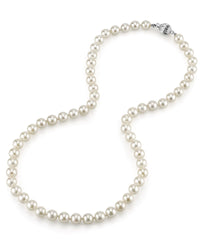
Japanese Akoya White Pearl Necklace, 6.5-7.0mm - AAA Quality
$1,540.00 Sale: $1,232.00


METALLIC RAINBOW
This stunning drop-shaped metallic Edison Freshwater necklace measured 14 -15mm in size! The color saturation and metallic luster combined with larger than life sizes made this layout a tempting treat!

Every day we receive questions from customers all over the world about pearls. We decided to post our answers here for every one to read!


Luster is arguably THE MOST important aspect of a pearl’s value, beating out surface quality, symmetry of shape, size and color by a mile. If a pearl doesn't have nice luster, it just isn't going to be worth much. Luster is one of the famous “Value Factors” that jewelers, pearl specialists and appraisers use to grade pearls.
Pearl luster has three components:
All four of the major pearl types require a rating of “High to Very High” luster in order to be graded “AAA Quality”. However, each pearl type plays with light in its own unique way and should be evaluated on a scale that takes that into account.

No two pearls are alike, and one of the factors that makes each different is its surface quality. Virtually no pearl is perfect, and any flawless specimens are treasures
The majority of pearl buyers will have a degree of surface imperfections on their gemstones. Pearl aficionados know that even the finest pearls will have irregularities on the surface. The key factors to surface quality irregularities are how noticeable they are and if they seriously affect the durability of the pearl.
Serious surface quality issues are usually chips and gaps, which will lower the value of even the most lustrous pearls. Why? These particular imperfections can cause the pearl to crack or peel. Other characteristics include:
Some surface characteristics are hardly noticeable, even to a pearl expert. A good example would be a minor flaw near the hole drilled in the pearl.

Nacre is the substance from which pearls are made. Since nacre determines luster, nacre quality is a critical factor when determining a pearl's value. Generally speaking, the thicker the nacre, the more valuable the pearl. Thick nacre not only looks better than thin, it also is much more durable.
Nacre quality is usually broken up in three categories:
Important to Know! If dealing with quality pearls, they should fall into the "acceptable" category.


Close your eyes, and picture in your mind a pearl necklace. We’d bet $100 that what you envisioned is the classic white Akoya pearl necklace, perfectly round in shape. But what if we told you it doesn’t have to be that way?
Shape is one of the more important Value Factors that jewelers use to grade and value pearls.
The gold standard when it comes to pearl’s shapes is of course perfectly Round. It is the rarest and the most valuable in addition to the most “classic” shape for most pearl shoppers.
But beyond Round, what you are looking for in a nice-looking pearl shape are characteristics like smooth, symmetrical shapes. For this reason, smooth Drop Shaped pearls are the next most valuable pearl shape. Baroque pearls are generally considered the least valuable pearl shapes, but quite often baroques are highly collectible due to their unique nature.
Choosing the right pearl shape is often a case of “you know it when you see it”, but here are a few tips to point you in the right direction.
If you’re after a strictly “Classic” look, True Round pearls are the way to go. We recommend checking out Akoya pearls, Gem Grade Freshwater pearls and Round Tahitian and South Sea pearl necklaces.
If you still want that high-end Round pearl necklace look, but not the price tag, it is worth the time and effort to seriously consider Near-Round and Button-Shape strands.
Choose Drop-Shaped pearl necklaces if you want to slip into something unique but that still retains a romantic, chic aesthetic. Drops are also a great way to indulge in high-end Tahitian or South Sea pearls without that premium price tag that True Round pearls have.
Go for Baroque if you’re looking for something totally one of a kind, and you already have “the staples” covered. Whether they’re more classically Baroque shapes, heavily Circled pearls or you like looking at the wild child of pearls, the Free Form Baroque, your options are endless and endlessly entertaining.

Cultured pearls are measured in millimeters. Akoya pearls are measured in half-millimeter sizes … Akoya pearl necklaces, bracelets, earrings and pendants will feature sizes like 6.0 - 6.5 mm, 6.5 – 7.0 mm, 7.0 – 7.5 mm and so on.
Tahitian, South Sea and Freshwater pearls are all measured in whole-millimeter increments. Earrings, pendants, rings will feature size listings like 10.0 – 11.0 mm, 11.0 – 12.0 mm, 12.0 – 13.0 mm and the like.
A half-millimeter increase doesn’t sound like a lot at first, but that extra volume can really add up. Each increase in size generally translates to about a 15-20% jump in size.
Akoya pearls are one of the smallest cultured pearl types and can range in size from tiny 1.0 mm seed pearls up through 9.5 mm, and rarely 10.0 mm at their largest. The most popular and common sizes are 6.0 – 6.5 mm up through 9.5-10.0 mm.
Other items that can be used to help visualize pearl sizes are a #2 pencil, which is 4.25 mm in diameter, so a 6.0 – 6.5 mm pearl will be slightly larger than a pencil eraser. A marble measures about 10.0 mm, so the largest 9.5 mm Akoya pearl earring will be slightly smaller than that.
The most popular Akoya pearl sizes for necklaces, bracelets and earrings are generally 6.5 - 7.0 mm, 7.0 – 7.5 mm and up through 8.0 – 8.5 mm.